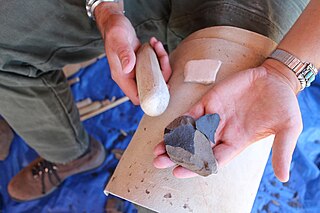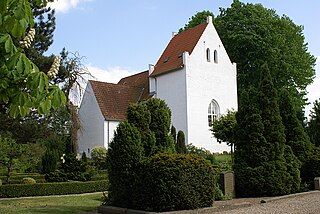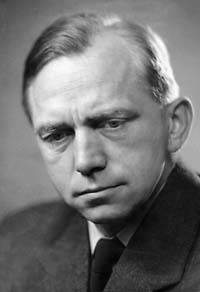

Land of Legends, Centre for Historical-Archaeological Research and Communication (Danish: Sagnlandet Lejre) is a 106-acre (43 hectare) archaeological open-air museum situated in the Lejre Municipality, few kilometres west of Roskilde, Denmark. [1]


Land of Legends, Centre for Historical-Archaeological Research and Communication (Danish: Sagnlandet Lejre) is a 106-acre (43 hectare) archaeological open-air museum situated in the Lejre Municipality, few kilometres west of Roskilde, Denmark. [1]
Lejre Land of Legends was formerly known as Centre for Historical-Archaeological Research and Communication (Historisk-arkæologisk Forsøgscenter). It was founded in 1964 by ethnologist Hans-Ole Hansen to create new knowledge of the past through experiments. On March 1, 2009, Lejre Experiment Centre changed its name to Sagnlandet Lejre.
The site comprises reconstructions of an Iron Age village and sacrificial bog (200 BC to 200 AD), a Viking market place (900 AD), a Stone Age campsite (5000 BC), an 18th-century farmstead and various grave monuments. The historical artisan workshops (pottery, weaver's workshop, smithy) work to reproduce pre-historical handicraft. Gardens, pastures and fields are the natural scenario of activities and reconstructions. [2]
Lejre researchers have re-created ancient crafts. Researchers have also explored in detail the ancient methods of food production. Activities for the public utilizes previous techniques, known from historical documents, archaeological evidence or experimental archaeology. [3]
Many archaeologists from all over the world come to Lejre to perform their experiments, dealing with a broad variety of subjects and artifacts. Lejre has also supported the experimental work of Errett Callahan (1937–2019) who was one of the world's most recognised flintknappers. [4]
Around 55,000 tourists and school children visit Lejre each year. Each summer many families spend a week of their holidays in the Iron Age village, the farm cottages and the Stone Age campsite. They dress in period costume and take on the role of peopling the reconstructed areas, while trying to live using the techniques of the past. [5]

A broch is an Iron Age drystone hollow-walled structure found in Scotland. Brochs belong to the classification "complex Atlantic roundhouse" devised by Scottish archaeologists in the 1980s. Their origin is a matter of some controversy.

Knapping is the shaping of flint, chert, obsidian, or other conchoidal fracturing stone through the process of lithic reduction to manufacture stone tools, strikers for flintlock firearms, or to produce flat-faced stones for building or facing walls, and flushwork decoration. The original Germanic term knopp meant to strike, shape, or work, so it could theoretically have referred equally well to making statues or dice. Modern usage is more specific, referring almost exclusively to the hand-tool pressure-flaking process pictured. It is distinguished from the more general verb "chip" and is different from "carve", and "cleave".

Lejre is a railway town, with a population of 2,834, in Lejre Municipality on the island of Zealand in east Denmark. It belongs to Region Zealand. The town's Old Norse name was Hleiðr or Hleiðargarðr.

Experimental archaeology is a field of study which attempts to generate and test archaeological hypotheses, usually by replicating or approximating the feasibility of ancient cultures performing various tasks or feats. It employs a number of methods, techniques, analyses, and approaches, based upon archaeological source material such as ancient structures or artifacts.
The Danes were a North Germanic tribe inhabiting southern Scandinavia, including the area now comprising Denmark proper, and the Scanian provinces of modern-day southern Sweden, during the Nordic Iron Age and the Viking Age. They founded what became the Kingdom of Denmark. The name of their realm is believed to mean "Danish March", viz. "the march of the Danes", in Old Norse, referring to their southern border zone between the Eider and Schlei rivers, known as the Danevirke.

The Nordic Bronze Age is a period of Scandinavian prehistory from c. 1750–500 BC.

The Viking Ship Museum in Roskilde is Denmark's national ship museum for ships of the prehistoric and medieval period.
The archaeology of Northern Europe studies the prehistory of Scandinavia and the adjacent North European Plain, roughly corresponding to the territories of modern Sweden, Norway, Denmark, northern Germany, Poland and the Netherlands.

The Ferriby Boats are three Bronze-Age British sewn plank-built boats, parts of which were discovered at North Ferriby in the East Riding of the English county of Yorkshire. Only a small number of boats of a similar period have been found in Britain and the Ferriby examples are the earliest known sewn-plank boats found in Europe.

Among the early Germanic peoples, a mead hall or feasting hall was initially simply a large building with a single room. From the fifth century to the Early Middle Ages such a building was the residence of a lord and his retainers. These structures were also where lords could formally receive visitors and where the community would gather to socialize, allowing lords to oversee the social activity of their subjects. The mead hall was generally the great hall of the king.

Middelaldercentret is an experimental living history archaeological open-air museum in Denmark, which depicts the middle ages in the Denmark of the late 14th and early 15th centuries. It is located in Sundby Lolland, some 4 km northwest of the centre of Nykøbing Falster on the waterfront of Guldborgsund.
Errett Callahan was an American archaeologist, flintknapper, and pioneer in the fields of experimental archaeology and lithic replication studies.

Moesgaard Museum (MOMU) is a Danish regional museum dedicated to archaeology and ethnography. It is located in Beder, a suburb of Aarhus, Denmark.
Mining archaeology is a specific field well-developed in the British Isles during recent decades. A reason of ongoing interest in this field is the particular bond between regional history and the exploitation of metals. References to mines in the area exist in Strabo's works. However the first accomplished study on the topic was attempted by Oliver Davies in 1935. Other momentous researches were that of geologist John S. Jackson about mines in Ireland and Lewis, Jones in Dolaucothi goldmine in Wales, and the pioneering work of Ronald F. Tylecote. Moreover, in the 1980s and 1990s a new generation of amateurs and scientists began investigations in different locations in the British Isles, including Duncan James on the Great Orme's Head, Simon Timberlake with the Early Mines Research Group at sites in Wales and William O'Brien in Ireland.
Experimental archaeometallurgy is a subset of experimental archaeology that specifically involves past metallurgical processes most commonly involving the replication of copper and iron objects as well as testing the methodology behind the production of ancient metals and metal objects. Metals and elements used primarily as alloying materials, such as tin, lead, and arsenic, are also a part of experimental research.
Tell Sukas is a Late Bronze Age archaeological mound on the Eastern Mediterranean coast about 6 kilometres (3.7 mi) south of Jableh, Syria.

The Gevninge helmet fragment is the dexter eyepiece of a helmet from the Viking Age or end of the Nordic Iron Age. It was found in 2000 during the excavation of a Viking farmstead in Gevninge, near Lejre, Denmark. The fragment is moulded from bronze and gilded, and consists of a stylised eyebrow with eyelashes above an oval opening. There are three holes at the top and bottom of the fragment to affix the eyepiece to a helmet. The fragment is significant as rare evidence of contemporaneous helmets, and also for its discovery in Gevninge, an outpost that is possibly connected to the Anglo-Saxon epic Beowulf. It has been in the collection of the Lejre Museum since its discovery, and has been exhibited internationally as part of a travelling exhibition on Vikings.

Gevninge is a village, with a population of 1,662, in Lejre Municipality on the island of Zealand in Denmark. Its old section is located alongside a small river, Lejre Å, approximately 2 kilometres (1.2 mi) from its mouth at Roskilde Fjord.

Alfred Martin Jens Hansen (20 August 1909 – 27 June 1955) was a Danish writer who wrote under the name Martin A. Hansen. He is known for his writings as a member of the Danish resistance movement during the German occupation of Denmark in WWII.
Coordinates: 55°36′57″N11°56′38″E / 55.61583°N 11.94389°E